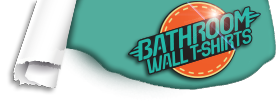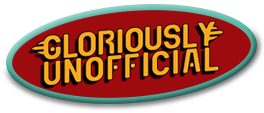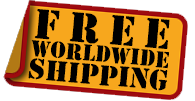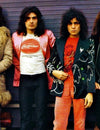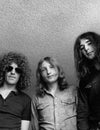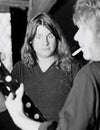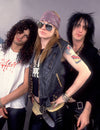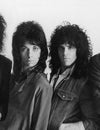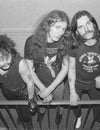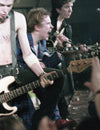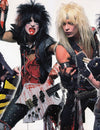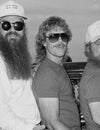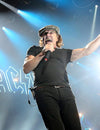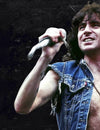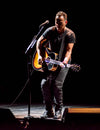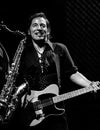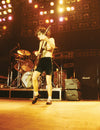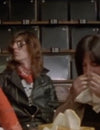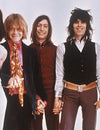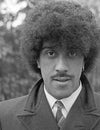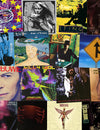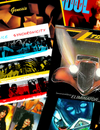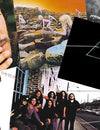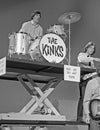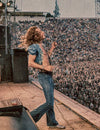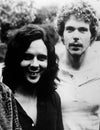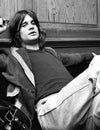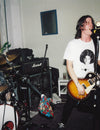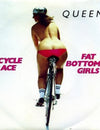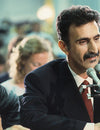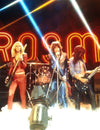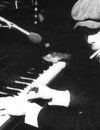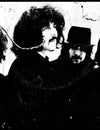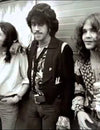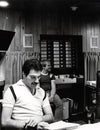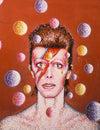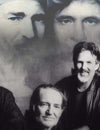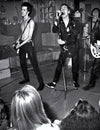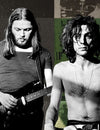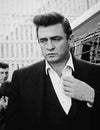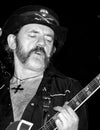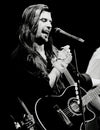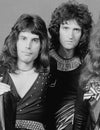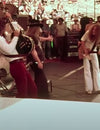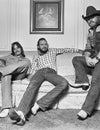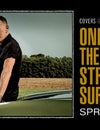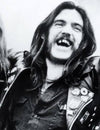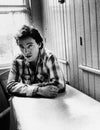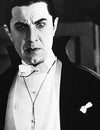
Led Zeppelin Tours North America: 1973 & 1975
By the early 1970s, Led Zeppelin was considered the biggest band in the world. “Houses of The Holy,” released in March 1973, became their fifth multi-platinum album despite the band only being formed five years earlier. They had eight North American concert tours under their belt, and on May 4th, 1973, the curtain would be raised once again.
Vocalist Robert Plant, guitarist Jimmy Page, bassist John Paul Jones, and drummer John Bonham were seasoned road veterans by that point and were no strangers to the North American landscape. Though they had toured the world, they played most of their shows in North America. In 1969, they played one hundred and thirty-nine shows, and only thirty-three of them were outside the United States. By 1971, they had already toured the US nine times. They were on a path that would see them shatter concert attendance records and reach heights of fame that were only rivaled by the Beatles.
Embed from Getty ImagesThe Evolution
When they took the stage at Atlanta’s Fulton County Stadium on May 4th, 1973, their stage show had evolved. They introduced dry ice, laser effects, backdrop mirrors, hanging mirror balls, and pyrotechnics to add another level of visual excitement to the already electric atmosphere. Jimmy Page recalls the band’s mindset at the time:
“Originally, we saw the whole essence of our live performance as something that the audience listened to very carefully, picking up on what was going on, the spontaneity and musicianship. And you can’t do that if you’re running around the stage all night, or at least we couldn’t back then...(By 1973) we were much more ambitious, in that respect. We really wanted to take the live performances as far as they could go.”
They played a standard setlist, including performing “No Quarter,” a song from the “Houses of The Holy” album, live for the first time. The setlist was:
“Rock and Roll”
“Celebration Day”
“Bring It On Home” (intro) / “Black Dog”
“Over the Hills and Far Away”
“Since I've Been Loving You”
“No Quarter”
“The Song Remains the Same”
“The Rain Song”
“Dazed and Confused”
“Heartbreaker”
“Whole Lotta Love”
Encores varied, but consisted of:
“The Ocean”
“Communication Breakdown”
“Thank You”
“Dancing Days”
They played for over fifty-three thousand fans in Atlanta, and that was just the beginning of what would be a record-setting tour that had them playing three-hour shows throughout. The next night in Tampa, they set the all-time North American concert attendance record - previously held by the Beatles’ Shea Stadium show in 1965 - playing in front of fifty-six thousand eight hundred fans. The road was all they knew, and their instruments provided their only comfort; Jimmy Page remembers:
“I mean, when I came back from the last tour, I didn't know where I was. I didn't even know where I was going. We ended up in New York, and the only thing that I could relate to was the instrument onstage...I was just totally and completely spaced out.”
They played a total of thirty-four shows: The first leg was eighteen shows, covering the Southeast and Southwest United States, and the second sixteen shows covered the Northeast, Northwest, and Midwestern United States & Canada.
The band's final three shows - July 27th, 28th, and 29th - at Madison Square Garden were filmed, and the footage was used to create their “Song Remains The Same” concert film that gave fans an inside look at the off-stage, on-the-road-lifestyle of the band.
The Starship
The first Boeing 720 ever built was bought by Contemporary Entertainment in 1973 from United Airlines to be used by private clients. After being fed up with flying in a smaller Falcon Jet, Zeppelin decided to lease it for the remainder of their tour. The Falcon’s small size made it prone to bouts of turbulence, and they decided it simply wouldn’t suffice.
The Starship was customized to seat 40. It had a bar, with seats and tables, revolving armchairs, a 30-foot-long couch, a TV, and VCR with a video library. There were rooms at the back of the plane; one with a low couch with pillows on the floor, and the other was a bedroom, with a white fur bedspread and shower. They had the band name painted across the outside of the plane. They enjoyed the use of the luxury Starship for the remainder of the 1973 tour and their 1975 North American tour.
Rock band Deep Purple used The Starship for their 1974 US tours. Keyboardist Jon Lord talked about the luxury in an interview with Circus Magazine:
"It's a 707 put together by a firm in L.A. that Sinatra, Dylan, and The Band just used, and Elton John uses. It has a lounge, a bedroom, a shower, and a study. It's supposed to look as little as a plane as possible."
Gregg Allman recalls finding lines of cocaine on the bar spelling out “Welcome Allman Bros” when the Allman Brothers chartered the plane for a tour.

Keep it Rollin’
Enter 1975: John Bonham and his bandmates were enjoying an eighteen-month-long hiatus from the road; their longest break between shows to that point. When they ventured out for yet another North American tour, they upped their game once again. They adopted a spectacular light show that included a large neon-lit “Led Zeppelin” backdrop and krypton laser effects to accompany Jimmy Page's violin bow interlude.
The setlist was typically this:
“Rock and Roll”
“Sick Again”
“Over the Hills and Far Away”
“When the Levee Breaks”
“Since I've Been Loving You”
“The Song Remains the Same”
“The Rain Song”
“Kashmir”
“The Wanton Song”
“No Quarter”
“Trampled Under Foot”
“Moby Dick”
“How Many More Times" / "Dazed and Confused”
“Stairway to Heaven”
Facing Adversity
Before embarking on the tour, Jimmy Page slammed his ring finger into a train door, breaking it. Aided by painkillers, he adopted a three-finger playing method to keep the first shows of the tour going. Early in the tour, Robert Plant was battling the flu, and the band had to cancel a show in St.Louis. Though the setbacks led to some bad reviews, Plant claimed: “This has been our most successful tour on every level, and I had a great time all the way through.” They played thirty-four shows on the tour, and it further cemented their legacy.
In a scary or maybe funny moment, Manson Family member Lynette Alice "Squeaky" Fromme demanded to speak with Jimmy Page to warn him of "bad energy." She claimed she could see the future, and Page was in danger. Later that year, she attempted to assassinate U.S. President Gerald Ford, unsuccessfully.
The life of a rockstar is never boring.
